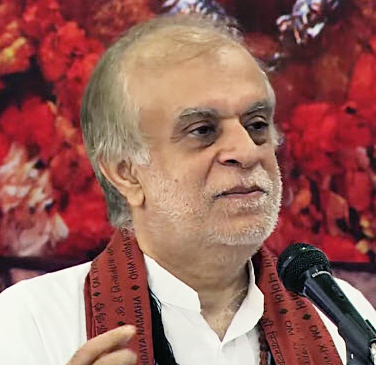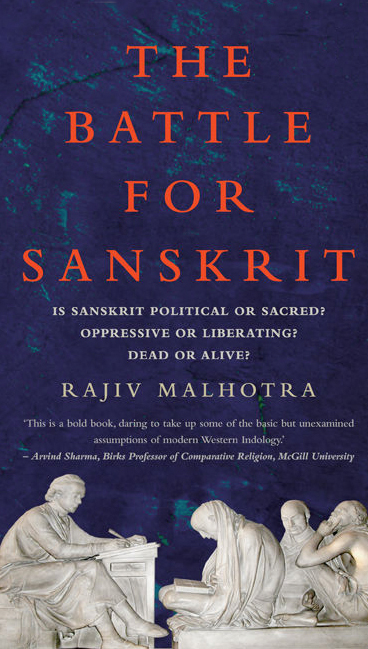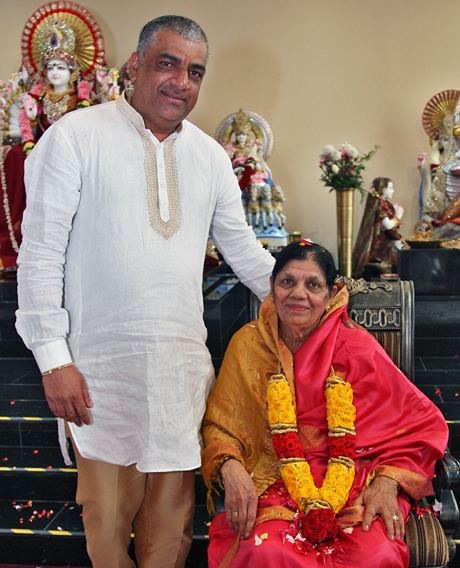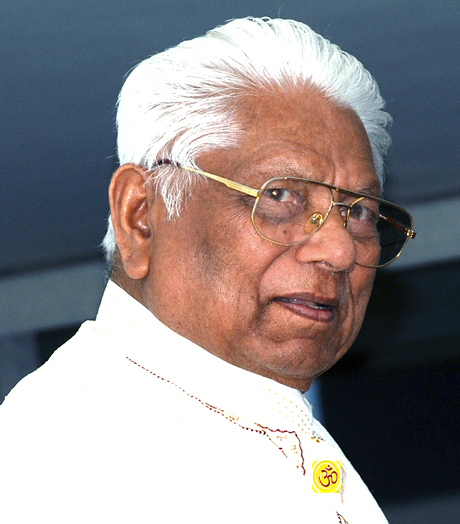Community Connection
'The Battle for Sanskrit'

Imagine sitting next to an American academic on a flight to India, where you have decided to spend the next two weeks on a search for your ancestral roots (your ancestors were forcibly removed from India more than a century ago to work on sugar plantations in Guyana and other erstwhile British colonies). You strike up a conversation with this individual, who proceeds to tell you: (1) that Sanskrit is a dead language, (2) that early Sanskrit texts were socially oppressive and served as political weapons in the hands of the ruling elite, and (3) that there is no sacredness in Sanskrit, or if there was any, it should be stripped of any spiritual elements and reinterpreted through a strictly political perspective.
The academic proceeds to explain a phenomenon which pervades American academia, where highly acclaimed scholars have written books, articles in academic journals, etc. propagating this theory. In fact, US schools are currently teaching “Ramayana” using a workbook developed by Susan Wadley, incorporating these very interpretations/perspectives.
Rajiv Malhotra’s latest tome, The Battle for Sanskrit investigates and deconstructs these claims in great detail, supported by numerous references. The book meticulously researches the claims being promoted in American indological studies. He calls this relatively new area of study “American Orientalism.” ('Orientalism' is a term popularised by the American scholar of Palestinian origin Edward Said in 1978, to describe the European lens through which non-European cultures were analysed and depicted during the colonial era using western categories, i.e. the way the west perceived and described the east. Said understood quite profoundly that inherent in the process of domination is the need by the dominating culture to rationalize its domination. Hence, the use of such terms as heathens, natives, savages, uncivilized, etc.)
Malhotra’s book is not about learning Sanskrit! It’s about the story of Sanskrit and the civilization it spawned, over many millennia in the land of Bharat. It identifies and defines many key areas of debate in what the author calls the “Battle for Sanskrit”. Sanskrit provides the vocabulary with which the Indian civilization (called Sanskriti) is encoded. It became the medium for expressing a distinct set of cultural systems and experiences. In addition to the library of Hindu religiosity ensconced in Sanskrit, there is a wealth of Sanskrit literature from poets like Kalidasa, Abhinavgupta, and numerous others. (Imagine my first disappointment when reading Vikram Seth’s book “A Suitable Boy”; Seth claims Hindu priests are chanting mantras in a dead language).

India had in the past been a producer of knowledge in many fields (in fact, India had the first universities in the world, long before the present Christian Era, which students from all over the known world at the time attended and learned Sanskrit in the process of their studies). But this pre-eminence has now been lost: India is now an importer of knowledge, even in respect of its own history, culture, science, etc. (Contrast this position with that of the Chinese, who exert full control over the discourse on the Chinese civilization.) Now the producers of knowledge, irrespective of its accuracy or veracity, are outsiders to the Sanskriti civilization. (The terms “insiders” and “outsiders” are specifically defined in the book itself). The adhikara for dharma knowledge generation has moved from India itself to America. Ironically, another group of westerners from various disciplines of study are steadily mining the rich, comprehensive, and voluminous Sanskrit bases in philosophy, yoga, health sciences, theology, adhyatmic (inner) sciences, etc. and reproducing these as newly discovered western advances.
As in Indra’s Net, Malhotra deconstructs and debunks American Orientalism in this new book The Battle for Sanskrit. Although Sanskrit is the oldest language, and has existed for thousands of years, the West has appropriated Sanskrit studies over the last two hundred and fifty years, and now controls it. It is estimated that there are over five hundred thousand original Sanskrit manuscripts in European hands, and there is no hope of these ever being returned to their home, India. Beginning with Sir William Jones (1746–1794), who was an employee of the East India Company, and continued by Sheldon Pollock, the most prominent western scholar in Sanskrit studies today, the adhikara for Sanskrit studies has gravitated into western control, from which it is now probably impossible to recover.
Sheldon Pollock, an eminent professor of Sanskrit Studies at Columbia University in USA, is currently the primary exponent of the “Sanskrit is political, oppressive, and dead” school of thought. To be fair, Pollock, and his career so far, makes for compulsive reading. He studied at Harvard and is a brilliant scholar (under Western standards). Malhotra himself describes Pollock as the “foremost contemporary exponent and the most high-profile and influential exponent of American Orientalism”. Pollock has skillfully and successfully infiltrated, and holds influential positions in several Indian institutions, most prominently the Murthy Classical Library of India (MCLI), which started with an endowment of over $5M from Rohan Murthy, son of N.R. Narayana Murthy. Pollock leads this foundation, which aims to provide scholarly translations in English of classical works in various Indian languages. Also, until its closure, Pollock was the chief editor of the Clay Sanskrit Library, which had similar objectives as MCLI. Pollock received the President of India Certificate of Honour for Sanskrit in 2008, and was awarded the Padmashri in 2010. In 2013, he received the “Friend of India Award” from the prestigious India Abroad publication in the US. He is currently the Arvind Raghunathan Professor of South Asian Studies at Columbia University. (He had studied and obtained his PhD at Harvard.)
Pollock puts the blame for European racism and Nazism at Sanskrit’s door, and claims that “Brahmin elitism” was instrumental in British colonialism and Nazism, and that social oppressiveness was built into Sanskrit. He wrote the article: “Death of Sanskrit”, and studies Hinduism as an outsider, not as a practitioner (insider), and lacks grounding adhyatmic/inner sciences. However, Pollock is an avowed Marxist, which has an anti-religion perspective.
In a recent online article, Malhotra is described as “a prominent researcher, writer, and speaker, and public intellectual on current affairs as they relate to civilizations, cross-cultural encounters, religion and science. Among the issues on which he has raised awareness is that Indian civilization is studied through biased and distorted (and many times denigrating) lenses by western scholars. He has authored five best-selling books, including his latest The Battle for Sanskrit. Additionally, he is the main protagonist in Invading the Sacred, another book that bemoans the disrespectful manner in which Hinduism is being portrayed in American classrooms. He also holds a Ph.d in physics and has spent many years doing purva paksha (reverse gaze) of Western Indology.
The Battle for Sanskrit is not Malhotra’s foray into this area of controversy. More than ten years ago, he penned an article: “Geopolitics and Sanskrit Phobia” on Sulekha, an online website dedicated to the Indian diaspora; and a few years later wrote another article on “European misappropriation of Sanskrit led to the Aryan race theory”. He also gave keynote addresses at two World Sanskrit conferences in Thailand.
All his books/articles are based on meticulous, extensive research. He has extended the knowledge base of certain constructs explored in his prior work Being Different: An Indian challenge to western universalism. (He is a modern day exponent of the Indian dialectical technique of purva paksha/Uttara paksha). He utilizes many related academic and other references to build his arguments. Moreover, he argues from a decidedly insider (Sanskriti) perspective. He argues from a philosophical/knowledge-based understanding of the issues contained in each of his books, and most emphatically shuns ad hominems and misrepresentations. Moreover, his employment of the English language is precise and deliberate.
Malhotra has developed a new body of knowledge, which is fast becoming a field of study at university level. He is developing a new kurukshektra to challenge American Orientalism, which invariably denigrates Hinduism, and reduces it to a “cow, caste, and curry” mockery.
of Indentureship
The Vedic Cultural Centre/Toronto Arya Samaj (VCC/TAS) invites the public to a special program to observe the 100th anniversary of the discontinuation of Indian Indentureship, to be held on Saturday, May 6, 2017 at the Vedic Cultural Centre, 4345-14th Avenue, Markham. The system of Indentureship was officially halted in 1917 following strong lobby against the poor working conditions of the Indian labourers in foreign lands.
The program will also recognize the 150th Anniversary of Canada and the contributions of the Indian Diaspora to Canada and North America.
Author and retired physician, Dr Mohan Ragbeer will be the keynote speaker at this event which will also feature the launch of his latest book and an exhibition of his other books. This year also marks the 19th year that the VCC/TAS will be hosting its annual South Asian Heritage Month program and also commemorate the 179th anniversary of arrival of Indian indentured labour to the Western world. Indentureship of Indians commenced in 1838.
The program will address the spread of the Indian Diaspora through indentureship and its growth and contribution to the Western World in particular the Caribbean and by extension, North America, through a second wave of migration.
The program will also include historical exhibits capturing the contribution and experiences of Indians in the countries they were indentured. It will also feature a stage program reflecting the songs, dance and music that the Indentured Indians brought with them and that have survived to this day. An informative magazine reflecting the focus of this year's program will also be released for the event.
The exhibition and book launch will take place in the lower hall from 3pm to 6:30pm along with a cash ethnic food bar, while the stage program and keynote address will be from 7:00pm to 9pm in the upper hall. The stage program will also showcase Indo Caribbean artistes performing songs and singing styles that have survived the passage of time.
Admission is free and donations are welcome.
For further information contact Adit Kumar 647-866-1926, Sharada Bhajan 416-450-1743. Norma Jainarine 416-901-3404.

A Three Day Ramayan Yagna at the newly built, luxurious and prayer-inducing Bhavani Shankar Mandir in Brampton.
For the first two nights and the Sunday following, the capacity audiences joined with the Kissoon family in devotion and in inspiring discourses from the Ramcharitmanas delivered by Pandits Hardat Ashwar and Srikant Acharya.
Mrs Latchmin Kissoon was born on March 24th 1937 and married at age 15 to Sugrim Kissoon. They had seven children. But in 1979, at age 49, Sugrim passed away leaving to his 42-year old widow the daunting task of raising the brood by herself.
Mrs Kissoon migrated to Canada in 1982 with her five younger children as the two older ones – Janie and Dhaman – were already residing here.
Mrs Kissoon raised her children with amazing grit, compassion and resolve but above all, ske kept them together under her wings, nurturing and implanting in them her deep cultural convictions. They move together in so many social and community activities as a unified force; it's become a lesson in togetherness.
So no wonder that Mitra, the 6th of the seven children, whose birthday, like his mother's, was on March 24th (born in 1967) was simultaneously celebrating his 50th. Mitra was 12 years old when his father passed away. More than 10 years ago, he started a successful landscaping and snow removal business – Sugrim Maintenance Co. – named after his father. He has been involved in many charitable projects.
On the final day of the Ramayan Yagna, the eldest of the Kissoon siblings, Dhaman, announced the "Latchmin Kissoon Scholarship" to be offered to a graduating High School student going on to college or University. The student will be nominated by Bhavani Shankar Mandir and approved by the Kissoon Family. It will run for 10 years with an annual value of $1000. Students must have a minimum B+ average coupled with community involvement and a commitment to work in the community upon graduation.
Both the Doobay Medical and Research Centre and McMaster University Medical Centre have been serving people in desperate need of kidney dialysis since 2011. The majority of those served cannot afford dialysis treatment and many are treated at no charge.
All proceeds go to prevent and treat kidney disease particularly in the poorest segments of the Guyanese population.
The two Centres can provide this treatment because of the generous support of individuals and corporations.
Please support this valuable and deserving cause.
Coolie Coolie Veins is an exhibition that is currently up at Glenhyrst Gallery in Brantford, that uses the end of indentureship as a principal ruse. The exhibition which started on March 25- runs through to May 21, 2017.
Coolie Coolie Veins is a study of the afterlife of indentureship. Indentureship was the colonial system of labour that brought Indians and other people to the Caribbean to replace slave labour on plantations. The program ended in 1917.
Through his work, Andil Gosine interrogates the system’s historical legacy a century later, both in the social and political construction of Indo-Caribbean communities, and for its formative impact on its descendants’ most intimate experiences. In this exhibition, he interrogates himself through consideration of his experiences of pleasure and violence in the places he lived: a rural village in the Caribbean island of Trinidad, Southern Ontario cities Oshawa and Toronto, the English beachside town of Brighton, and other metropolitan centres in the United States and Europe.
For more details, check out Gosine's website at: www.andilgosine.com

Shreeman Oudai Chandrapal
December 16,1926 – April 2, 2017
He had four sisters and two brothers all of whom had passed away making him the only surviving sibling. Shreemaan Oudai was a hardworking and dynamic individual. Though he never attended school, he faced the many challenges of life and became a very successful businessman.
Most of his employment in his early years was centered in the Leonora Sugar Estate Factory. His first job as a mule driver earned him 0.24 cents per day. He held several lower order, lower paying jobs at the factory that included: member of the creole gang, cutting cane, driving mules, backing canes, bailing punt, backing bagasse, weeder, vacuum pump and water pump operator.
He was also an assistant Health Inspector and worked for the Government in the Sea-Defence Department earning $1.50 per day.
Shri Oudai Ji then ventured into his own business as a goldsmith peddling jewellery from house to house and village to village. While engaged in this activity, he met his wife, Shreemattie Rani who was a seamstress. They got married in Leonora on December 8th 1948 by Pt. Seupersaud. In 1950, their first child, Dinesh (Ramesh) was born and in 1951 they built their first home at Lot 16, Leonora Seafield, W.C.D. where they started a small business (cake shop). He used his carrier bicycle to transport merchandize from Georgetown to Leonora. The business prospered and eventually expanded to include a grocery and hardware store consisting of building materials, pharmaceuticals, bicycles, cooking gas etc.
In the late 1950s Shri Oudai Ji and his family embraced the Arya Samaj Movement and were instrumental in establishing a branch in Leonora. He became the Treasurer of the organization, a position he held until he migrated to North America.
Working seven days a week the family lived a simple life but still found time to engage in their religious activities. Shri Oudai Ji was an active member of the American Aryan League (later the Guyana Central Arya Samaj). He was a willing volunteer for Samaj and community activities and regularly contributed financially. His was a heart of gold.
One of his last acts of philantrophy before leaving Guyana for Canada was to donate a substantial sum of money to establish a Trust Fund in the name of the Guyana Central Arya Samaj to be used for the education of youths. The Trust grew with contributions from others allowing the interest only for granting scholarships. He also made significant donations to other religious and charitable organizations prior to his departure.
He also helped many people to migrate overseas by being guarantors so that those individuals could pursue their dreams.
In 1984 Shri Oudai Ji and his wife migrated to New York to join their children and later moved to Toronto in 1987, where they continued to be active in the Arya Samaj Movement in and around the GTA. They are founding members of Vedic Mission Scarborough Inc., the Mandir they attended regularly prior to his demise.
Two of their children, Pt. Ramesh and Acharya Vijay, are currently involved in propagating Vedic Dharma in Toronto; their other children are also involved in religious activities in both Toronto and NY.
In May 2016, Shri Oudai Ji returned to Toronto from a visit to New York and soon after suffered multiple strokes. He was admitted to the Humber River Hospital and never recovered. On 2nd April 2017 he breathed his last.
Shri Oudai Ji is survived by his wife, Shreemattie Rani Chandrapal and his eight children: Pt. Ramesh Chandrapal, Sita Premlall (USA), Suresh Chandrapal, Mukesh Chandrapal, Vidya Chandrapal (USA), Prakash Chandrapal, Savita Chandrapal (USA) and Acharya Vijay.
He will be missed very much by his family, relatives and friends. May God bless his soul.
(Submitted by relatives of the deceased)
The single will eventually be the first track on the TTE's sixth album, also titled Bhumika currently in production and scheduled for release in early 2018. The album emphasizes the technical and energetic nature of Indian rhythms featuring several percussion and melodic instruments in addition to the tabla. The pieces will be augmented with the help of guest artists from other World music traditions including composer and multi-instrumentalist, Donald Quan, and Japanese Taiko master, Kiyoshi Nagata.
Since 1991, the TTE has helped bring tabla to the mainstream music scene in Canada with its innovative concerts and recordings. The Ensemble has produced three music videos and five original albums.

